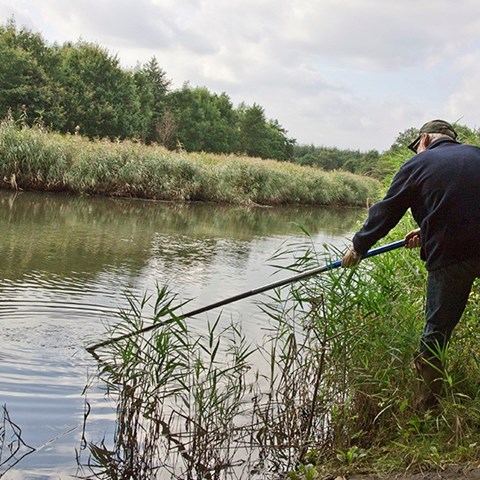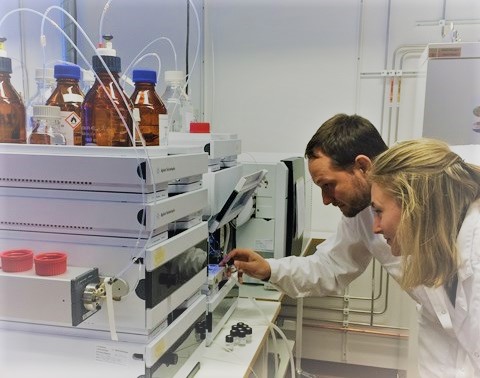Contact
Mikaela Gönczi, Director
SLU Centre for Pesticides in the Environment
mikaela.gonczi@slu.se, +46 18-67 31 05

There are a range of different factors to take into account if the results of an investigation of pesticides are to be as useful and correct as possible. It may be difficult to take samples in the environment, so it is important to consider the purpose of the investigation and find a suitable arrangement that is capable of giving the best possible results, give a specific budget. Useful guidance is to read about how previous investigations were conducted.
The purpose of the investigation determines e.g. what is to be sampled (surface water, groundwater, soil, sediment, precipitation etc.), choice of sampling site, which substances are relevant for analysis, when samples are to be taken, sampling rate, sampling technique (instantaneous or time-integrated samples), sample-handling, analytical methodology, measuring other variables (e.g. precipitation or flow in a watercourse) and information about conditions in the catchment area. It is important to take all these factors into account, but also to be consistent so that the results obtained are comparable with those from previous studies. Some of the more important factors to consider before sampling in surface water or groundwater are described in the following sections.
Those wishing to carry out a more extensive investigation of pesticides are advised to read the Swedish Environmental Protection Agency’s ‘investigation types’, which describes the structure and methodology for measurements within national environmental monitoring of pesticides.
The time of sampling can play a significant role for the results, particularly if the aim is to investigate a body of surface water. The concentrations in water courses, especially smaller streams, can vary sharply from day to day - sometimes from one hour to the next. The greatest risk of higher concentrations is after heavy rain during the spraying season, while the concentrations are often lower during periods with less spraying and in dry conditions. Groundwater concentrations usually change more slowly than they do in surface water.
An investigation aimed at providing a general description of the incidence of pesticides in surface water should adjust sampling according to the spraying season. In southern Götaland this can take place from April, when weed control begins, to November, when weed control and autumn ploughing are finished. In northern Götaland and Svealand the spraying season can take place from May to October. It can be a good idea to phone an agricultural advisor (e.g. in the county council or Hushållningssällskapet) to obtain information on the spraying season, its length, when it is most intensive and the compounds that are sprayed in the area under investigation. This also simplifies interpretation of the results.
However, if the aim is to investigate the groundwater, time of sampling plays a lesser role for the results since the turnover time of groundwater is considerably slower, particularly that of deep groundwater. However, where and to what extent the water in a well/borehole is replaced in relation to the time of sampling can be important.
Regardless of the type of water investigated, it is important to repeat sampling on different occasions in order to confirm the results and to eliminate chance.
When taking samples, it is important to handle the sampling equipment and the sample in such a way that the contents are not affected or changed from when the sample is taken up to when it arrives in the laboratory. Begin by avoiding contamination of the test equipment by thinking about how it is stored before and during sample-taking. There is a high risk of samples becoming contaminated if the inside of the bottle or cap is touched, or if the cap is left on the ground during sampling. Note also that certain substances may be volatile, while others can adhere to the sampling equipment if the wrong materials are used.
The risk of substances to be analysed being altered or lost between sampling and analysis, for example as a result of decomposition or due to heat, is minimised by ensuring that transport to the laboratory is rapid (within a day) preferably in chilled conditions. Since the substances are often found at very low concentrations, even minimal contamination or incorrect handling of a sample may result in major deviations in the results.
Detailed instructions on how sampling should be carried out and what to be aware of usually accompany the sampling bottles sent out by the laboratory in charge of carrying out analyses.
For general guidance on sampling techniques and the design of sampling programmes for different types of water, standards have been issued by ISO (SS-EN ISO 5667-1:2007 and SS-EN ISO 5667-1:2007/AC:2007), which can be purchased through SIS (Swedish Standards Institute).
Many different compounds have been used as pesticides over the years, some that have been banned and others that have replaced them. They have been used for different purposes and in different ways. The compounds that are relevant to analyse in a sample depend for example on whether the surface water or groundwater is being investigated. The pesticide residues present in surface water are often a reflection of what is in current use, while those found in groundwater are more a reflection of what has been used in the past, sometimes several decades in the past, within different sectors of society. An indication of the types of compounds that are relevant for analysis can be gained by looking more closely at the type of use that has existed and still exists in the immediate area. Is it agricultural use, urban use or forestry use that dominates? It is often difficult to predict which substances will appear since there is, and always has been, a great variation in how the products are used, especially before the current stricter regulations for use and handling were introduced in the 1990s.
There are several different places to look for information on the compounds that are relevant in different questions.
The Swedish Chemicals Agency publishes annual reports with statistics on quantities of different compounds sold (1986 onwards). Their website also has a search function where information can be sought on areas of application, or on a certain compound.
By using the risk assessment tool MACRO-DB, the risk of different compounds leaching to the surface and groundwater can be simulated. This can be a help when assessing the compounds most relevant to analyse.
On the website for the National environmental monitoring of pesticides you can find the annual reports (in Swedish) in which the latest results are presented. You can also search on which substances are found in the agriculture-intensive areas in Sweden that are included in the investigation or other results of analyses collected from different parts of Sweden for surface water, groundwater or drinking water.
If the water to be sampled is affected by farming, it is best to get in touch with an experienced agricultural advisor in the region, as they usually have good knowledge on the compounds used in the area. This depends partly on the crops grown and partly on the insects and fungi that occur.
Pesticides are usually found at very low level in water. What determines a relevant analytical level usually depends on why the sample was taken, and what type of water it is, which has to do with what information the analytical result is expected to provide and what it is to be compared with. Comparison would usually be with threshold values or guideline values in order to be able to assess whether the water quality is acceptable in terms of levels of plant protection products.
The detection threshold of the analysis is accordingly of decisive importance. The detection limit is the lowest concentration at which it can be verified that the substance is present in the sample with reasonable statistical reliability. For concentrations close to the detection limit, only a qualitative determination can be made, i.e. it can be stated whether the substance is present in the sample or not. Such cases are sometimes reported as trace values by analytical laboratories and not as reliably quantified as values above the quantification threshold, sometimes referred to as the reporting threshold or the limit of determination.
For drinking water the regulations (SLV FS 2001:30, in Swedish) state that the detection limit must be 25% of the maximum permissible value. For individual pesticides the maximum permissible value has been set at 0.1 µg/L, which means that the detection limit may be at most 0.025 µg/L. The exceptions are the compounds aldrin, dieldrin, heptachlor and heptachlorepoxide, for which the maximum permissible value is 0.03 µg/L and therefore a corresponding lower detection limit is required.
The reason for analysing substances at levels lower than the maximum permissible value is to detect trends, i.e. to determine whether the concentrations are on the way up and approaching the maximum permissible value, in order to implement countermeasures in good time, before the maximum permissible value is exceeded and the water is classified as undrinkable.
For groundwater the same limit value as for drinking water applies, i.e. 0.1 µg/L, according to the EU directive on groundwater (2006/118/EC). A further criterion for both groundwater and drinking water is that the sum of concentrations of individual pesticides may not exceed 0.5 µg/L.
However, in the case of surface water there is no general limit value as regards the incidence of pesticides. Instead, individual substances have their own threshold values linked to how toxic they are to aquatic organisms in surface water.
There are threshold values that are legally binding due to EU Directives and guideline values that are not legally binding, but which have been produced by the Swedish Chemicals Agency in order to be able to follow up on Sweden's environmental quality objectives. In addition to these, the CKB has produced a number of preliminary guideline values in order to be able to assess results from the Swedish National Environmental Monitoring Programme. The website of the Swedish National Environmental Monitoring Programme has all threshold values and guideline values, as well as references, collected for those substances included in the environmental monitoring programme.
Threshold and guideline values specify the maximum concentration at which a substance cannot be expected to have any negative effects on aquatic organisms. The detection limit for substances analysed in surface water should be lower than the guideline value for the respective substance, in the same way as for drinking water and groundwater. However, some substances have very low guideline values, for example that for esfenvalerate is 0.0001 µg/L. This is a level that can be difficult to detect if the analytical method is of a general nature, i.e. includes a large number of different substances.
When analysing pesticides it is important to place demands on the laboratory so that interpretation of the results is easier. You should of course check that the laboratory is accredited for the correct sample type (also referred to as matrix, e.g. water, soil etc.) and relevant measurement range with respect to levels of the substances in question. Similarly, for the purposes of the investigation it is worthwhile knowing the detection limit, limit of determination and accuracy of measurement, in order to ensure that the substances can be traced down to the level needed for the investigation. Some other aspects to consider are:
If the sample is to be used for some form of legal case, a high degree of transparency is needed in the entire chain from sampling in the presence of an independent observer from the local authority or police, labelling, documentation (for example photographs) and transport, to the analyses at the laboratory. The analyses should be performed as so-called documentary analyses by one, or possibly two, accredited laboratories. This means that the sample must be analysed on two independent occasions, in order for the results to be as reliable as possible.
There are a number of laboratories in Sweden that analyse for pesticides.

Mikaela Gönczi, Director
SLU Centre for Pesticides in the Environment
mikaela.gonczi@slu.se, +46 18-67 31 05